Table of contents
- Review of the Sachsenring Classic 2015 Time’s running!
- Dozens of machines from the MZ factory fleet
- Jan de Vries with his green Kreidler
- Guzzi V8 causes a stir
- Noise, smell, enthusiastic drivers and screwdrivers
- German Hirstorische motorcycle championship
- Age does not protect against speed
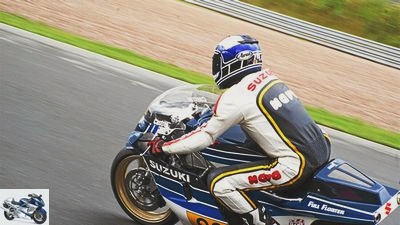
Wedemeyer
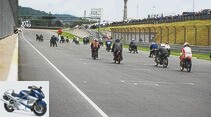

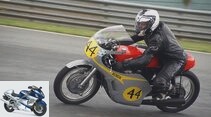

19th pictures
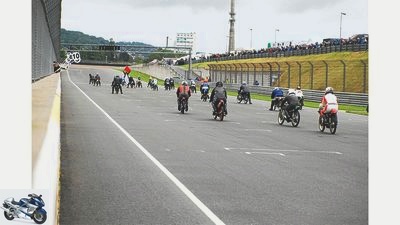
Wedemeyer
1/19
The old warriors make themselves and the material warm to the big show. The leather is tighter, but the gas hand twitches as ever.
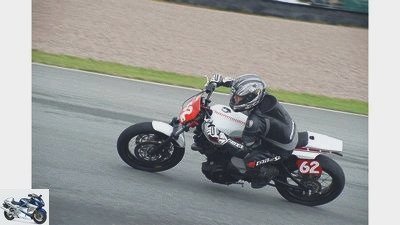
Wedemeyer
2/19
More impressions from the ADAC Sachsenring Classic.
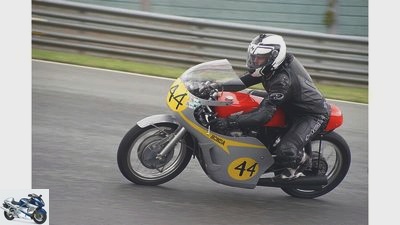
Wedemeyer
3/19
More impressions from the ADAC Sachsenring Classic.
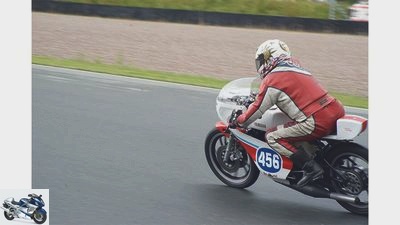
Wedemeyer
4/19
More impressions from the ADAC Sachsenring Classic.

Wedemeyer
5/19
More impressions from the ADAC Sachsenring Classic.
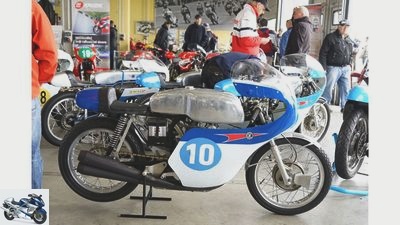
Wedemeyer
6/19
No barriers: the many runners can be admired in peace.
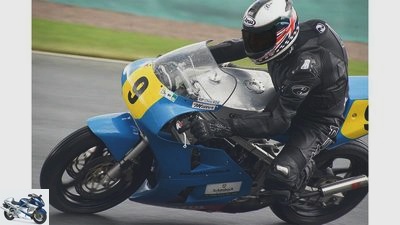
Wedemeyer
7/19
More impressions from the ADAC Sachsenring Classic.
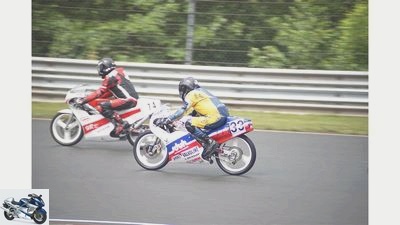
Wedemeyer
8/19
More impressions from the ADAC Sachsenring Classic.
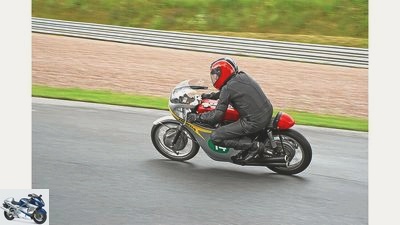
Wedemeyer
9/19
Driving legends like the GP Hondas are real crowd pullers. The old machines also cut a good figure on the slopes.
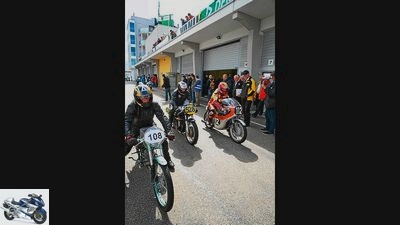
Wedemeyer
10/19
At the Sachsenring, the audience is also welcome in the pits.
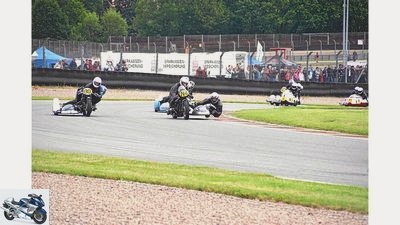
Wedemeyer
11/19
The teams also let it fly. Sometimes a wheel is lifted.

Wedemeyer
12/19
Fleet two-stroke engines like this Suzuki are simply part of the DHM.
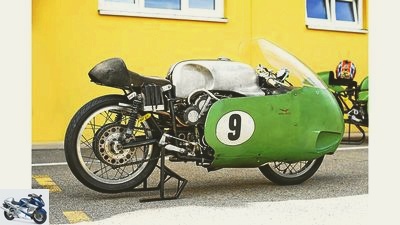
Wedemeyer
13/19
Always surrounded: a picture of the rare Guzzi V8 without an astonished audience is a rarity.
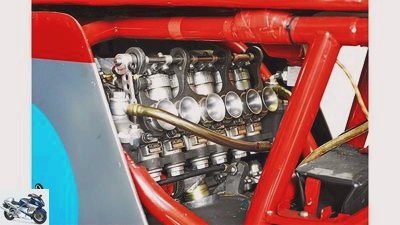
Wedemeyer
14/19
Three small double carburetors fuel the MV. From these funnels a divine sucking sound can be heard.
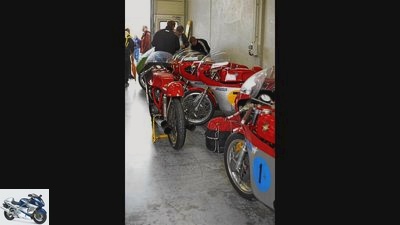
Wedemeyer
15/19
Concentration: The abundance of classics is simply breathtaking.
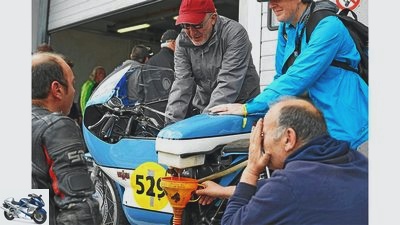
Wedemeyer
16/19
Teamwork: draining the fuel on the old Bianchi.
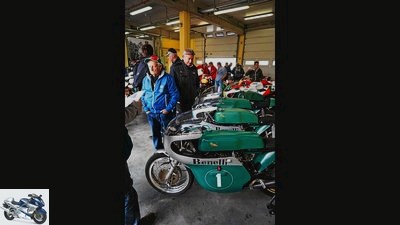
Wedemeyer
17/19
The Benellis are an absolute feast for the ears.
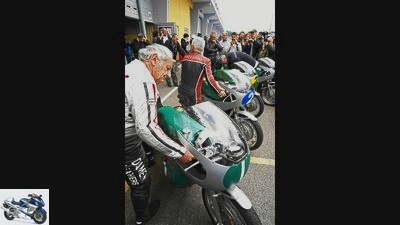
Wedemeyer
18/19
The second edition of the ADAC Sachsenring Classic brings together countless motorcycle legends. People and machines make it clear to the enthusiastic audience how two-wheel racing has developed over the decades.
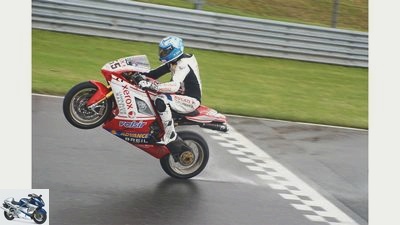
Wedemeyer
19/19
More impressions from the ADAC Sachsenring Classic.
Sports & scene
Events
Sachsenring Classic
Review of the Sachsenring Classic 2015
Time’s running!
Content of
The second edition of the ADAC Sachsenring Classic brings together countless motorcycle legends. People and machines make it clear to the enthusiastic audience how two-wheel racing has developed over the decades.
Sven Wedemeyer
08/06/2015
Anyone wondering today what fascination motor sport held for the masses decades ago generally goes to Goodwood. Or to Hockenheim. Or after spa. The atmosphere there, but above all the authentic impressions of the street races of earlier times, can best be soaked up there. Old machines, historic routes, great legends … It now almost seems as if another, still young event is establishing itself in the fans’ calendar: the ADAC Sachsenring Classic.
Buy complete article
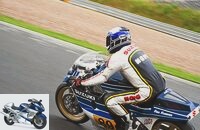
Review of the Sachsenring Classic 2015
Time’s running!
6 pages) as PDF
€ 2.00
Buy now
As soon as you step into the paddock, you notice how closely the people around the Sachsenring are connected to motorsport. After all, the history of the mountain and valley route near Chemnitz goes back to 1927. Back then, when the Badberg Vierecks race on the country road and across Hohenstein-Ernstthal attracted hundreds of thousands of people. The Nurburgring was opened in the same year. Since then, the fire for motorsport has blazed in many people in the region. Especially since MZ from Zschopau heated up the gasoline-fueled identity of the Saxons over many decades and generations. There were even times when you belonged to the absolute elite of two-wheelers.
Dozens of machines from the MZ factory fleet
Those days are long gone, unfortunately. But they are still being celebrated! At the latest, now the second edition of the Sachsenring Classic in mid-June, it is therefore not surprising that dozens of machines from the MZ factory fleet are present – including many, still astonishingly sprightly drivers. The offspring also seem to follow them. Because even the generation under 40 devotes themselves to the MZs with a lot of love. The brand’s legacy is cultivated, respected and cherished. A whole armada of blue-silver or green-silver racers populates the paddock. They dig deep in the olden days, adjust carburetors or align chains. Heinz Rosner, called “Mister MZ”, or Ralf Waldmann happily hop through the box because of the two-cycle noise. There are also other brands from the former Eastern Bloc, such as Jawa or a couple of wonderful CZ, along with the former factory drivers. This brings back old memories for many visitors from the region.
But the event offers more than just a look back at motorsport in the East. The loaded racing legends come from all over the world. In a total of 13 classes, in addition to a few cars, countless motorcycles start. Many of them come from Italy, Spain or Japan. In total, however, no fewer than 20 nations are represented. Even New Zealander Hugh Anderson, a former road world champion of the 50 and 125 class in a Suzuki, was not deterred by the long journey. He celebrated his first podium in 1962 at the Sachsenring. Many of his colleagues at the time followed him and placed their roaring Grand Prix machines from MV Agusta, Honda or Gilera in the pit lane.
Jan de Vries with his green Kreidler
But there is also a lot going on on the course. A horde of extremely slim and flat 50s flies over the start-finish straight like a frightened swarm of hornets. Jan de Vries, who has at least two world titles under his belt, is at the forefront with his green Kreidler. From the pits, and even better from the grandstands of the three paddocks, you can enjoy the action on the curvy asphalt. Competent moderation echoes from the loudspeakers, while a new pack of great classics takes to the track every half hour.
Meanwhile, a couple of gracefully aged Italians bring the engine oil of their Benellis up to operating temperature in the box. For ten minutes, their gas pounds and the uninhibited rumble from the megaphones shake the scene. One might think that the plaster would crumble from the ceiling immediately because of the hard staccato. The men are visibly proud in their tight-fitting leather. “Look what we can do on the slopes!” They seem to shout cheerfully. Even old eyes can sparkle. The admiring to frightened-looking audience knows how to enjoy the extremely rich soundscape. The crowd is always looking for the next, loudest and most interesting place in the box. But still: a kingdom for a few earplugs!
Guzzi V8 causes a stir
It’s no less squeamish in the box next door: Again it’s the Italians who are causing a stir. This time with a Guzzi V8. The “Otto Cilindri” was probably the culmination of racing in the mid-fifties. Eight small pistons, distributed over 500 cubic meters and breathing through filigree 20 mm carburettors, allowed the racing machine to hyperventilate up to 14,000 revolutions. At that time, 80 hp was considered a fabulous value, which was good for over 270 things with full fairing. With drum brakes and the thinnest tires! The lime green two-wheeled monument from Mandello is still impressive today – with its craftsmanship, mechanical sound and a good portion of patina. The rare Guzzi – there are probably only five of them left – looks like it came straight from the 1957 Grand Prix in Monza. Just fantastic!
The list of rare, partly no longer existing brands and motorcycles can be continued at the Sachsenring Classic: AJS, Norton, Vincent, Mondial, Bianchi, but also the NSU Sportmax or Cagivas 500s from Eddie Lawson will take you back in time. In supposedly better times, when motorsport was definitely more dangerous, but perhaps also more eventful.
Noise, smell, enthusiastic drivers and screwdrivers
The historical diversity makes one on the Sachsenring aware in this unusual intensity how far the time has progressed. Even with the Pro Superbikes, relatively modern machines like the Yamaha OW01 or a Ducati 888, you can quickly poke deeper than 20 years into history. You can also see the years in the Superbike riders, stars like Michael Galinski or Peter Rubatto. But still: The not so fresh guys are still having a blast on the ring. You give everything. In addition to the German Historic Motorcycle Championship, which is really about victory or defeat, the Superbike heroes of the 90s are real crowd pleasers.
And it is precisely that – the noise, the smell, the enthusiastic drivers and mechanics, but above all the immediacy of the whole spectacle – that makes historic motorsport at the Sachsenring so attractive. Because where else is almost the entire evolution of street sport, from the pre-war team to the superbike, presented in such a concentrated manner in just one weekend?
In the paddock, which is accessible to all spectators, you can see the two-wheeled beauties very deeply under the fairing, you can help old-age racers push the car or you can talk to legends like the Swiss Luigi Taveri at the autograph session. For Honda in the 1960s he won three world titles and three class wins at the TT. And, like many of his colleagues, apparently has no reason for a peaceful retirement. The audience is fine. It knows that time is running out – especially at the Sachsenring.
German Hirstorische motorcycle championship

Wedemeyer
The teams also let it fly. Sometimes a wheel is lifted.
For a moment it was really like before. The ignition was turned off at the start. There was silence for a few seconds. Then the co-drivers ran off, pushed the historic carriages and finally jumped into their position. That was once the custom.
A total of 28 sidecars started at the ADAC Sachsenring Classic. It was an elitist mix of Sitzer and Kneeler sidecars that were built until 1967. Between numerous replicas that were closely based on the original, there were also two flawless racing rarities: the BMW RS 54 racing machine from Ewald Dahms from 1954 and the Kneeler BMW from Theo Sattler, which the Black Forest native bought in 1968 and has been looking after since then. Dahms, who once bought and restored the BMW, and Sattler, who already demonstrated his racing skills in the OMK Cup in the 1970s, are two originals themselves. The two are 77 and 68 years old respectively and have by no means taken the gas out of their lives. The regularity runs, which were held in Saxony for the first time, were included in the evaluation of the German Historical Championship (DHM). How seriously the old treasures are being fought there, says DHM organization manager Stephan Otto, who not only acts as a desk operator, but also leans out of the boat as a co-driver in Dieter Wandelt’s self-made team: “We are fully attacking. The accounts will be settled at the end. “Wandelt / Otto are the current defending champions and are currently third overall.
Age does not protect against speed
The 33 solo motorcycles, divided into classes E (Vintage / Post Vintage, 1920 to 1949) and H (up to 250 cm³, 1950-1967), also offered the fans great cinema. The drivers of the pre-war models with between 30 and 40 hp, which have no suspension or disc brakes, had to show a lot of courage and feeling in the demanding corners of the Sachsenring. “But for the 250s, which weigh 130 kilos, have 35 hp and are around 160 km / h fast, it was pure enjoyment,” says Stephan Otto, who hopes to be able to push another class to the grid next year.
Related articles
-
jkuenstle.de 17th pictures jkuenstle.de 1/17 Sachsenring Classic 2016. jkuenstle.de 2/17 Sachsenring Classic 2016. jkuenstle.de 3/17 Sachsenring Classic…
-
Review of the Sachsenring Classic 2016
jkuenstle.de 49 pictures ADAC 1/49 Picture gallery: Sachsenring Classic 2016. jkuenstle.de 2/49 In addition to the World GP Bike Legends, there were…
-
Pro Superbike revival at the ADAC Sachsenring Classic 2014
fact 50 pictures fact 1/50 ADAC Sachsenring Classic 2014 fact 2/50 ADAC Sachsenring Classic 2014 fact 3/50 ADAC Sachsenring Classic 2014 fact 4/50 ADAC…
-
MOTORRAD drives 125cc classic racers
motorcycles MOTORRAD drives 125cc classic racers MOTORRAD drives 125cc classic racers Dream job 30 years ago he was allowed to sit on it as a young…
-
racepixx 13th pictures Racepixx.de 1/13 KTM Duke Battle Sachsenring 2013 Racepixx.de 2/13 KTM Duke Battle Sachsenring 2013 Racepixx.de 3/13 KTM Duke…
-
MotoE starts at the Sachsenring
La Moto Sports & scene Motorsport MotoE starts at the Sachsenring MotoE pavilion with racing motorcycles burned down MotoE starts at the Sachsenring New…
-
The best stories from 25 years of MOTORRAD Classic
archive Sports & scene The best stories from 25 years of MOTORRAD Classic 25 years of MOTORRAD Classic A quarter of a century MOTORRAD Classic Content of…
-
Report VIP race training at the Sachsenring
racepixx.de Sports & scene Report VIP race training at the Sachsenring Report VIP race training at the Sachsenring Professional racing drivers as…
-
On the way along the Ahr with the Enfield Royal Classic
Deleker 23 pictures Deleker 1/23 On the way through the Eifel with the Enfield Classic 500 EFI. Werel 2/23 A day in the Eifel with a driven distance of…
-
Thomas Schmieder 41 pictures Thomas Schmieder 1/41 Sunday Ride Classic in the south of France. Thomas Schmieder 2/41 Sunday Ride Classic in the south of…